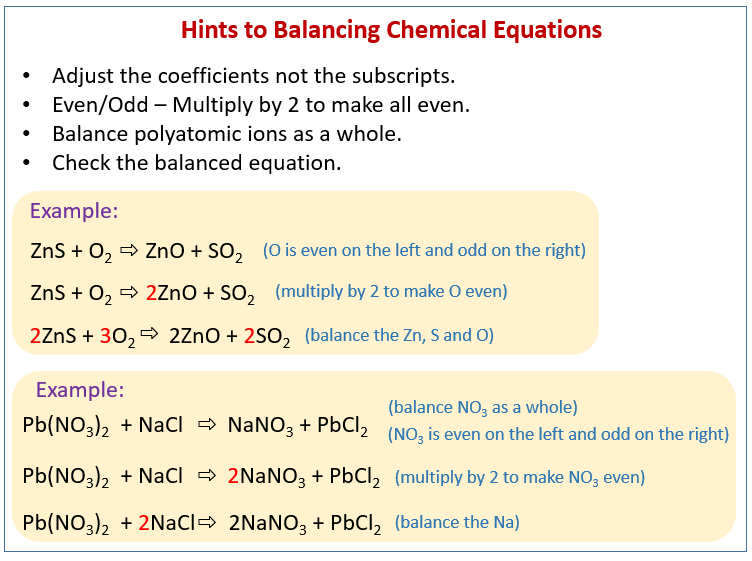Balancing chemical equations
Related Topics:
More Lessons for Chemistry
Math Worksheets
Atoms can neither be destroyed nor created during a simple chemical reaction. Therefore, in a chemical reaction
The sum of atoms before reaction = the sum of atoms after reaction
What is a balanced chemical equations?
A Balanced Equation has the same number of each type of atom on both sides of the arrow.
How to balance chemical equations?
The following figure gives some hints on how to balance chemical equations. Scroll down the page for more examples and solutions.

Introduction to Balancing Chemical Equations
In this video, we’ll start out with examples that show the concepts behind balancing chemical equations.
- Start with a word equation.
- Write a chemical equations.
- Visualize the atoms and molecules and how they change.
To figure out if the equations is balanced, we look at the number and type of atoms on each side of the arrow. If the number and type of atom is not the same on both sides, the equation in unbalanced. We need to change the number of one or more of the compounds in order to get the atoms to balance. We do this by placing coefficients (numbers) in front of each of the compounds. When balancing equations, you cannot ever change the subscripts of a compound.
Example:
Write a balanced equation for the following word equation.
a) Hydrogen gas and Chlorine gas combine to make Hydrochloric Acid.
b) Hydrogen gas and Oxygen gas combine to make Water.
c) Hydrogen gas and Oxygen gas combine to make Hydrogen Peroxide.
b) Nitrogen gas and Hydrogen gas combine to make Ammonia.
Balancing Chemical Equations Practice Problems
In this video, we’ll see the process or trial and error and the steps that you have to go through to balance chemical equations.
- Keep track of the number of atoms on both sides of the equation.
- Add coefficients to one or more of the elements and compounds to make the number of atoms equal.
Example:
Balance the following equations. - C + SO2 → CS2 + CO
- Xe + F2 → XeF6
- KOH + CO2 → K2CO3 + H2O
- Na + Cl2 → NaCl
- FeO + C → Fe + CO2
- SiO2 + C → SiC + CO
- FeCl3 + NaOH → Fe(OH)2 + NaCl
- Al + H2SO4 → Al2(SO4)3 + H2
- NH3 + CuO → Cu + N2 + H2O
Interactive Activities and Games to help you practice balancing chemical equations
Balancing Chemical Equations Activities
General Rules for balancing chemical equations – Rule 1
Balancing chemical equations may require some trial and error. There are some general rules that could be helpful, but they may not work all the time.
- Rule 1: Balancing chemical equations using the one’s and two’s technique
- Rule 2: Balancing chemical equations using the two’s and three’s technique
- Rule 3: Balancing chemical equations using the CHO technique
- Rule 4: Balancing chemical equations using the even technique
- Rule 5: Balancing chemical equations containing polyatomic ions
In this page, we will look at some examples of applying
Rule 1: Balancing chemical equations using the one’s and two’s technique.
Example:
Balance the equation
K + O2 → K2O
Solution:
Step 1: On the left side of the equation there are 2 oxygen atoms and on the right side of the equation there is one oxygen atoms. Multiply K2O by the coefficient of 2 to balance the oxygen atoms.
K + O2 → 2K2O
Step 2: Balance the K by placing the coefficient of 4 in front of K
4K + O2 → 2K2O
Step 3: Check that all the atoms balance and make sure that all coefficients are in the lowest-possible ratio.
Examples of using the one’s and two’s method to balance chemical equations
Example:
Balance the chemical equation
Ca + O2 → CaO
Example:
Balance the chemical equation
K + O2 → K2O
Try the free Mathway calculator and
problem solver below to practice various math topics. Try the given examples, or type in your own
problem and check your answer with the step-by-step explanations.

We welcome your feedback, comments and questions about this site or page. Please submit your feedback or enquiries via our Feedback page.